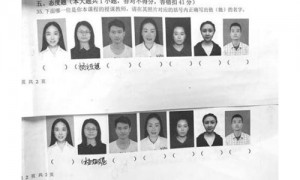China-Trinidad and Tobago cultural relations expanding
The cultural relations between China and Trinidad and Tobago have grown by leaps andbounds in recent years, with an increasing number of exchange visits by art groups and morediversified forms of performances, China's Ministry of Culture said.
Wuju, a kind of opera in Jinhua, East China's Zhejiang province, is one of the favorites of thepeople of Trinidad and Tobago.
In March, China's Ministry of Culture sent the Wuju Opera Troupe of Zhejiang to perform at theQueen's Hall in Port of Spain.
Yan Lixin, director of the troupe, said their performances were highly praised by LincolnDouglas, the country's Minister of Arts and Multiculturalism.
"Douglas said he was so lucky to have the opportunity to enjoy the splendid Chinese localopera," Yan said. "He had a meeting to attend on the night of the show, but he enjoyed theWuju show so much that he left reluctantly at the last minute before the meeting started."
The troupe was not the first Chinese art group to perform in the island country.
According to China's Ministry of Culture, art exchanges have been carried out since the twocountries established diplomatic relations in 1974, and in the past, China's acrobatics wascommonly seen in Trinidad and Tobago.
In January 2005, China signed a cultural agreement with Trinidad and Tobago to enhanceartistic and cultural exchanges between the two countries.
The two countries agreed to encourage and support direct contact and cooperation betweengovernmental and non-governmental institutions, organizations and people in fields such astheater, music, dance and other artistic groups.
Artistic and cultural exchanges will continue, the Ministry of Culture said.
Yang Le, a 31-year-old folk singer from People's Culture Center in Luohu district, Shenzhen,Guangdong province, went to Trinidad and Tobago with other Shenzhen folk musicians anddancers in May 2012.
Their first performance in the country was given in the national center for the performing arts,where all the 1,200 seats were sold out. "When the curtain went down at the end of theperformance, we got a standing ovation," Yang said.
Zhang Chonggao, director of Weifang Kite Fair Office of Shandong province, shared the goodmemories he had when he and his colleagues exhibited Weifang traditional kites in Trinidadand Tobago.
Zhang, 50, who has been working in the kite industry for 12 years, was an organizer of theWeifang Kites Exhibition held in Trinidad and Tobago in November 2012. In a stadium, Zhangand his colleagues showed people how to fly the traditional Weifang kites.
"Many people, grown-ups, children and even government officials were attracted to fly the kitestogether with us," Zhang said. "The activity went on for a whole afternoon, and we all had fun."
中国与特立尼达和多巴哥的文化交流由来已久,传统的中国文化越来越多的受到当地人民的喜爱。
婺剧是浙江金华的地方戏,和京剧之间有着很深的渊源,也有很多的相似之处。作为中国传统戏曲表现形式之一,婺剧在今3月漂洋过海来到中美洲的岛国特立尼达和多巴哥,在当地表演轰动一时,受到极大追捧。
今年3月,受我国文化部的委派,浙江婺剧团前往特多进行访问演出。婺剧团书记严立新说,剧团的演员们于3月15日在特多首都西班牙港的女王音乐厅向当地观众献上演出,特多文化部部长林肯?道格拉斯对婺剧表演着迷不已。
严立新告诉记者,“道格拉斯先生说,他为自己有机会看到如此精湛的中国地方戏曲感到非常幸运。演出当天,道格拉斯先生本来有一个重要会议要参加,但他一直观看婺剧演出,直到会议开始之前的几分钟才不情愿地离开。”
演出结束后,严立新向在座观众询问观看演出的感受。“他们都竖起大拇指对我说,‘表演很精彩’。”
浙江婺剧团并不是第一支在特多大受欢迎的中国文化交流团队。
据文化部透露,中国和特多在1974年正式建立外交关系后,中特多间一直保持频繁的文化往来,尤其是中国的杂技艺术,早些年就走进了特多的表演舞台。近年来,中国和特多在文化领域的关系发展顺利,艺术团组互访逐年增多,文化交流的形式也更加多元。
歌唱家杨乐表示,如果有机会,她想再次到特多访演。
今年31岁的杨乐是一名民族女歌唱家,就职于深圳罗湖区群众艺术馆。2012年5月,在文化部的组织下,她曾与其他十余位深圳的民乐演奏家和民族舞蹈家一起,组成“深圳爱华艺术团”,前往特多进行文化交流演出。
距离杨乐在特多的表演已经过去一年,但当时令她感动的细节仍然历历在目。
杨乐说,“特多的观众非常热情,也很礼貌大方,让我们觉得我们的表演非常受欢迎,我们自身也很受尊重。”
爱华艺术团的首场演出在特多的国家表演艺术中心举行,现场1200个座位座无虚席,表演中掌声不断。
“当我们的演出结束时,几乎所有观众都从座位起身,为我们热烈地鼓掌,”杨乐说,“掌声持续了一分多钟,我们只有不断地鞠躬谢幕,回应观众的热情。”
杨乐说,特多人民,尤其是当地大学生不仅非常喜欢中国的民乐,同时对中国的语言也表现出极大的兴趣。
杨乐回忆说,在当地的一所大学,她演唱了享誉海内外的中国民歌《茉莉花》,以及2008年北京奥运会的主题曲《我和你》。
演唱结束后,一群学生围在后台,努力用中文和杨乐交流,还用中文说,杨乐的歌声有如“天籁之音”。
“我真的很惊讶,”曾到多个国家进行演出的杨乐说,“我从没想到,外国观众竟然会用这个四字成语。”
“那些学生还告诉我,他们对中国以及中国文化很有兴趣,正在当地汉语老师的帮助下学习中文。”杨乐说。
除了官方委派的艺术团组外,中国民间艺术交流团体组织的展演也在特多大受欢迎。
山东潍坊风筝会办公室主任张崇高讲述了他们和特多民间进行风筝交流的故事。
今年50岁的张崇高从事风筝行业已有12年,去年11月,他带领潍坊风筝会办公室积极组织协调,在特多举办了一次潍坊风筝展。
张崇高告诉记者,特多作为中美洲岛国,海风强劲,当地居民非常喜欢放风筝。但特多的风筝是现代风筝,外观多为规矩的几何图案,容易放飞,但外形比较单一。
因此,当特多人民看到龙头蜈蚣、蝴蝶、老鹰、凤凰、八卦等造型多样、颜色缤纷的风筝时,他们很快就迷上了这些来自中国潍坊的传统风筝。
在当地的一处体育场,张崇高和他的同事一起向特多民众展示如何放飞潍坊风筝,“当地居民,包括老人、小孩,还有很多官员,都被我们手里的风筝吸引住了,都走过来和我们一起放飞。”张崇高说,“风筝的放飞表演进行了整整一下午,所有人都很高兴。”
一些当地居民对造型奇特的潍坊风筝非常着迷,有的人还询问张崇高和他的同事,自己能不能亲手摸一摸这些漂亮的风筝。
“他们摸过之后都竖起大拇指,说简直栩栩如生。”张崇高说。
潍坊天成飞鸢公司经理王永训说,在特多展出的风筝都出产自他们公司,当时他们带了3000多只成品和半成品的潍坊风筝到特多,总共价值2万多元。
制作风筝已经20年有余的王永训,曾在特多的一所小学向学生们展示潍坊风筝的制作工艺。
“那些孩子年纪都很小,也不懂我们在说什么,”王永训说,“但他们的观察得很仔细,领悟得也很快,在我们的帮助下做出了很漂亮的风筝。”
王永训说最终他们将带去的3000多只风筝悉数赠给了当地的居民和学生。“我们可以感受到他们对潍坊风筝发自内心的喜爱。”
2005年1月,中特多两国签订了《中华人民共和国政府与特立尼达和多巴哥共和国政府文化合作协定》,以促进两国之间的艺术文化交流。
根据协定,中特多双方应鼓励、支持两国适当的官方与非官方的机构、团体与个人之间建立直接联系和合作关系,以推动戏剧、音乐、舞蹈等多个领域的艺术文化交流。
中国文化部也表示,两国之间的艺术文化交流仍在进行,未来也将不断地持续下去。
(中国日报记者赵欣莹编译)







